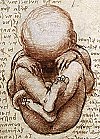
Back Adolessensie Afrikaans مراهقة Arabic Adolescencia AST Yuqalla Aymara Yeniyetməlik Azerbaijani یئنییئتمه AZB Падлетак Byelorussian Падлетак BE-X-OLD Юношество Bulgarian কৈশোর Bengali/Bangla

| Part of a series on |
| Human growth and development |
|---|
 |
| Stages |
| Biological milestones |
| Development and psychology |
Adolescence (from Latin adolescere 'to mature') is a transitional stage of physical and psychological development that generally occurs during the period from puberty to adulthood (typically corresponding to the age of majority).[1][2] Adolescence is usually associated with the teenage years,[3][4] but its physical, psychological or cultural expressions may begin earlier or end later. Puberty typically begins during preadolescence, particularly in females.[4][5] Physical growth (particularly in males) and cognitive development can extend past the teens. Age provides only a rough marker of adolescence, and scholars have not agreed upon a precise definition. Some definitions start as early as 10 and end as late as 30.[6][7][8] The World Health Organization definition officially designates an adolescent as someone between the ages of 10 and 19.[9]
- ^ Stehlik, Thomas (2018). Educational Philosophy for 21st Century Teachers. Springer. p. 131. ISBN 978-3319759692.
- ^ Hu, Julie Xuemei; Nash, Shondrah Tarrezz (2019). Marriage and the Family: Mirror of a Diverse Global Society. Routledge. p. 302. ISBN 978-1317279846.
- ^ "Puberty and adolescence". MedlinePlus. Archived from the original on April 3, 2013. Retrieved July 22, 2014.
- ^ a b "Adolescence". Psychology Today. Retrieved April 7, 2012.
- ^ Dorn L. D.; Biro F. M. (2011). "Puberty and Its Measurement: A Decade in Review. [Review]". Journal of Research on Adolescence. 21 (1): 180–195. doi:10.1111/j.1532-7795.2010.00722.x. ISSN 1050-8392.
- ^ Jaworska, Natalia; MacQueen, Glenda (September 2015). "Adolescence as a unique developmental period". Journal of Psychiatry & Neuroscience. 40 (5): 291–293. doi:10.1503/jpn.150268. PMC 4543091. PMID 26290063.
- ^ Perica, Maria I.; Calabro, Finnegan J.; Larsen, Bart; Foran, Will; Yushmanov, Victor E.; Hetherington, Hoby; Tervo-Clemmens, Brenden; Moon, Chan-Hong; Luna, Beatriz (2022). "Changes in prefrontal GABA and glutamate through adolescence supports excitation/Inhibition balance" (PDF). doi:10.1101/2022.04.25.489387. S2CID 248421494.
- ^ Steinberg, L.; Icenogle, G.; Shulman, E. P.; Breiner, K.; Chein, J.; Bacchini, D.; Chang, L.; Chaudhary, N.; Di Giunta, L.; Dodge, K. A.; Fanti, K. A.; Lansford, J. E.; Malone, P. S.; Oburu, P.; Pastorelli, C.; Skinner, A. T.; Sorbring, E.; Tapanya, S.; Tirado, L. M.; Alampay, L. P.; Al-Hassan, S. M.; Takash, H. M. (2017). "Around the World, Adolescence is a Time of Heightened Sensation Seeking and Immature Self-Regulation". Developmental Science. 21 (2): 10.1111/desc.12532. doi:10.1111/desc.12532. PMC 6473801. PMID 28150391.
- ^ "Adolescent health". www.who.int.